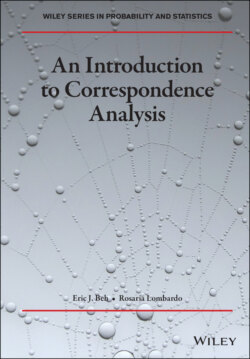Читать книгу An Introduction to Correspondence Analysis - Eric J. Beh - Страница 11
Preface
ОглавлениеIn the late 2000’s we embarked on a rather ambitious project to write a book that covered an extensive array of topics on correspondence analysis. This work resulted in the publication in 2014 of Correspondence Analysis: Theory, Practice and New Strategies. The attempt in that book was to provide a comprehensive technical, computational, theoretical and practical description of a variety of correspondence analysis techniques. These focused largely on the analysis of nominal and ordinal categorical variables with a symmetric and asymmetric association structure. We not only described these techniques for two variables but also discussed how they can be used and adapted for analysing multiple categorical variable.
Irrespective of the benefits and faults of that book, we attempted to give an extensive number of different perspectives. While our general flavour may be more in line with the French approach to correspondence analysis we also tried to approach our discussion by incorporating the British/American conventions of categorical data analysis commonly seen throughout the world. A priority we had was to not just provide a synthesis of a broad amount of the correspondence analysis literature from all around the world but to also discuss the role that the origin of categorical data analysis had on the development of correspondence analysis.
From writing the 2014 book we quickly realised that it may contain too much information for someone who was not well versed in some of the more subtle or obscure aspects of correspondence analysis. We also became aware that some didn’t feel the need to wade through an extensive literature review and technical discussion, but instead wished to focus on the key features of the analysis. So, after taking some time to take a deep breath and stretch our collective muscles, we dived back into writing again to focus on a book with more of an introductory, or tutorial, flavour than the first book allowed. This book is the result of those deep breaths and muscle stretches.
There are many contributions in the statistics, and allied, literature that provide an introduction to correspondence analysis. However many of these focus primarily on the classical approaches that have been around for decades and deal, for the most part, with the visual depiction of the association between nominal variables. Many of these contributions are also discipline specific so that the terminology used, and the application made, are in terms of a particular data or area of research. Michael Greenacre’s book Correspondence Analysis in Practice, which is now in its third edition (as of 2017) provides an excellent introductory description of correspondence analysis. Despite the excellent discussion of a wide range of topics, his book focuses on nominal categorical variables and so deals with the more traditional approaches to performing correspondence analysis.
What makes this book distinctive is that we don’t just introduce how to perform correspondence analysis for two or more nominal categorical variables using the traditional techniques. This book also provides some introductory remarks on the theory and application of non-symmetrical correspondence analysis; a variant that accommodates for a predictor variable and a response variable. We also provide an introduction to how ordered categorical variables can be incorporated into the analysis. For the analysis of multiple nominal categorical variables we do give an introduction to the classical approaches to multiple correspondence analysis (which involve transforming a multi-way contingency table into a two-way form) but we also provide some introductory remarks and an application of multi-way correspondence analysis; a technique which preserves the hyper-cube format of a multi-way contingency table. For the sake of simplicity though, we restrict our attention to the analysis of three variables, but we do examine how to analyse their association when two of them are treated as a predictor variable and the third variable is treated as a response variable.
The one omission from this book is that we do not discuss multi-way correspondence analysis when some of the variables are ordered and some of them are nominal. We could certainly have included some introductory notes on how to perform such an analysis but we felt it was slightly beyond the scope of what we wanted to achieve with this introductory book.
Another point that we would like to make concerns the use of two terms we have used; association and interaction. We use association to refer to the general relationship that exists between two (or more) categorical variables while interaction describes the relationship between two (or more) specific categories from two (or more) variables.
Therefore, this book aims to help researchers improve their familiarity with the concepts, terminology and application of several variants of correspondence analysis. We do describe the theory underlying the statistical and more visual aspects of the analysis. We have also tried to make sure that this book reaches out to students and educators who wish to learn (and teach) the fundamentals of correspondence analysis. In particular, the introductory nature of this book should enable students enrolled in an honours degree (for those in countries such as, but not confined to, Australia, New Zealand, United Kingdom, Canada, Hong Kong and India), a masters program or a PhD in all fields of research to gain appreciation of this form of analysis. The only requirement we ask of the reader is to have some knowledge of introductory statistics. To help the reader, all of the techniques we described can be performed using three R packages that are available on the CRAN; these packages are CAvariants , MCAvariants and CA3variants . However, to avoid an overly long book, we have not provided any guidance on how these packages may be used (reckonizing that they will be constantly updated), although one may refer to their help files for guidance and insight into their use.
So, sit back, relax, and we hope you enjoy your journey into the world of correspondence analysis.
April 2020
Eric J. Beh
Newcastle, Australia
Rosaria Lombardo
Capua, Italy
